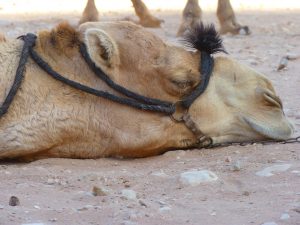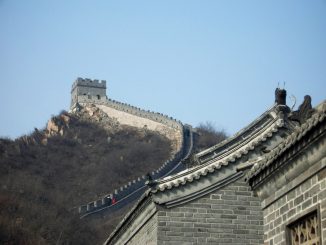
Famous for its rock cut architecture and advanced water conduit system, Petra is a historical city and archaeological site in Jordan. Inhabited since prehistoric times, Petra served as an important crossroads between Arabia, Egypt, and Syria-Phoenicia. Petra is often referred to as the Rose City because of the color of the stone from which it is carved. Half-built and half-carved into the rock, Petra is the most recognizable symbol of Jordan and is the most visited tourist attraction. One of The New7Wonders of the World, Petra has been listed as a UNESCO World Heritage Site since 1985. UNESCO described the site as “one of the most precious cultural properties of man’s cultural heritage”. Smithsonian Magazine considers Petra to be one of the 28 places to see before you die.
It is estimated that Petra was established as early AD 312 BD as the capital city of the Arab Nabataeans. Because of its proximity to important trade routes, the Nabataeans established the city as a hub for trading. Petra lies on the slope of the Jebel al-Madhbah in a basin among the mountains that run along the eastern edge of Arabah.

An earthquake in 363 AD destroyed the city’s water conduit system as well as many of the homes and buildings. After a following earthquake and the waning power of the Nabataeans it was decided that the city should be abandoned and many of the treasures were taken when it was left. In the 2nd century the Roman Empire took possession and control over Petra and there are traces of Roman influence in some of the art and architecture there. There are statues of Nike and a Greco-Roman deity named Dushara, paved streets, and a large Roman theater carved into a mountainside. The Roman control of Petra was to be short lived in the grand scheme of history however. When the Romans altered the Nabataean trade routes away from the city it was no longer an area that held any financial benefit for them. This move effectively took the population of 20,000-30,000 and removed the economy.
Outposts built during the Crusades are the last evidence that the West knew anything of Petra for half a millennium. Effectively forgotten about by the Western world till 1812, it was Johann Ludwig Burckhardt, the Swiss explorer that introduced it to the rest of the world. Petra is sometimes referred to as the ‘Lost City’ largely because it was hidden from the rest of the world for hundreds of years.
Petra Facts
- To enter Petra you have to pass through a narrow 1km long cliff-bound canyon called Al-Siq
- Continuous salt blowing from the Dead Sea is solidifying the pores of the sandstone and slowly deteriorating the structures.
- The complicated water conservation and irrigation system built by the Nabataeans made it possible for 30,000 people to live in an oasis in the desert complete with gardens and crops.
- Petra was once an important center of Christianity and has a 6th century AD marble pulpit from the Byzantine church called the Blue Chapel.
Travel Tips
- While touring the city of Petra, one can shop things such as authentic souvenirs of Jordanians and Nabateans. There is also a collection of stone carvings, embroidery, silverware and pottery.
- Among the Petra’s amazing architecture, The Treasury is the most popular. It is estimated to be over 2,000 years.
- Among the most popular monuments in Petra is the 2,100-pound sandstone bust of Dushara, Petra’s primary male deity.
- You will want to ask your driver to take the “Kings Highway” which isn’t as fast but is a scenic route that some locals call Jordan’s Grand Canyon.
- You can also stop at Karak Castle if you go this way.
- You need 7 hours to walk to the monastery and back.
- Skip the camel rides. They are expensive and Petra is so crowded that it’s sometimes difficult to navigate.
- The “chariot” is also expensive but worth the cost if you have trouble walking.
- Nothing is free. A two-day pass comes with a “free” horse ride that lasts about five minutes, but there is a required “tip” that can be about ten dollars depending on exchange rates.
- Don’t buy any “ancient items” while visiting Petra. Not only are the more than likely fake, it’s unlikely that they’re actually from the region and if they are authentic it may be illegal to take them home.
- Buy the two-day pass. It is nominally more expensive but much better than getting two one-day passes if you end up needing them.
- Starting at 8:30, every Monday, Wednesday and Thursday there is a light show, with about 1500 candles lighting the route through The Siq to The Treasury.
What to Bring
- Money
- There are lots of little things to buy along the way and everything costs.
- Make sure that you have enough cash to buy some things but not so much that you will be heartbroken if it’s stolen.
- Camera
- You can buy photos and postcards but it’s always nice to have pictures with you in them.
- Big bottle of water and snacks
- It gets hot… Bring some water with you because you’ll definitely need it and it will save you having to purchase water at an inflated price while you’re out walking around. You can of course buy snacks as well but they may not be what you are looking for and the options are scant for picky eaters.
- Sunscreen or sun protection.
- This includes hats and scarfs. Bringing a scarf with you can help protect you from the sun if you need it and wrapped around your face will keep the sand out of your teeth.
- Jordan is also a largely Muslim country and it is expected that women cover their heads when entering mosques.

